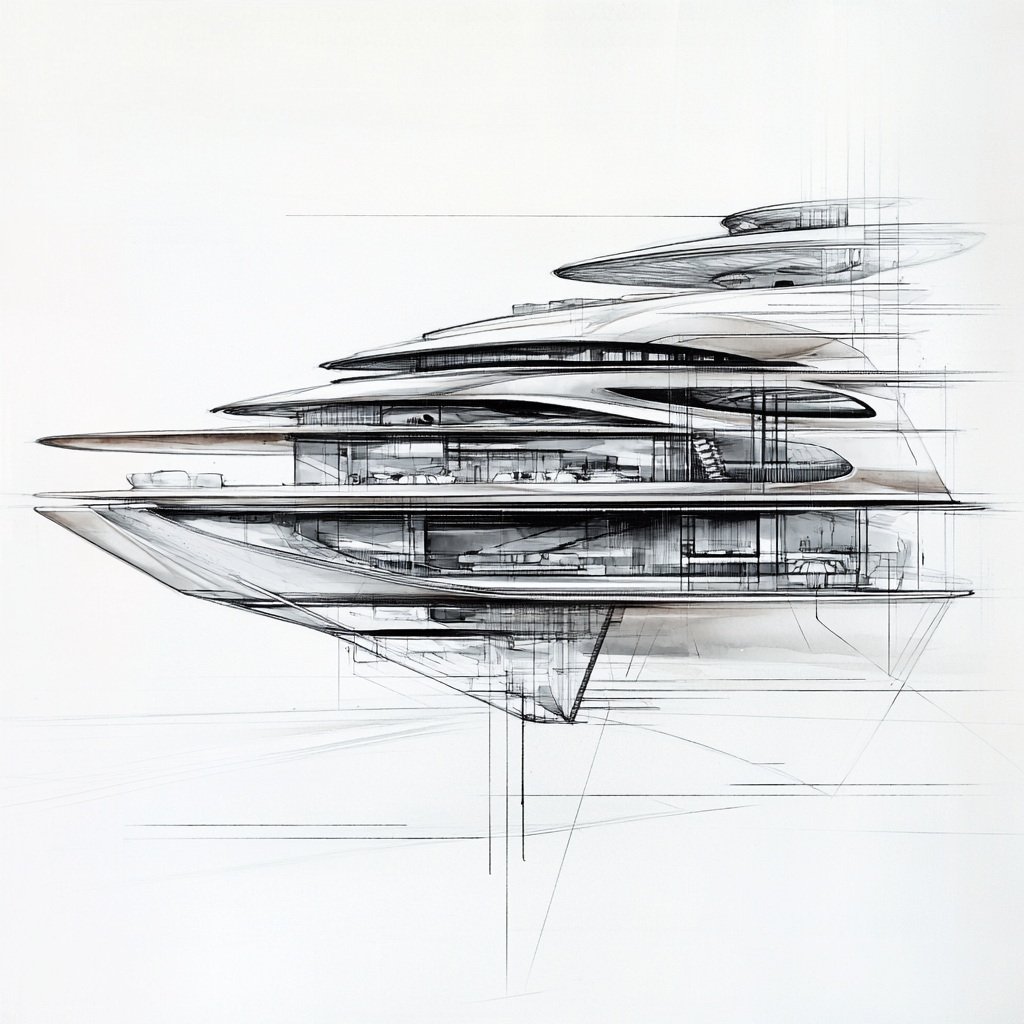
© OJrnl. All rights reserved
The Nautical Influence: From Hull to Habitat
As architectural practice continues to look outward for adaptive strategies, a new formal typology has begun to assert itself across concept studios and speculative design labs: the yacht-informed building. In a world shaped by rising sea levels, extreme climates, and shifting cultural attitudes toward luxury, these forms offer more than visual metaphor they offer an evolved approach to form, function, and flow.
The drawings presented here are an investigation of this emerging language. What they reveal is not simply a fascination with curvature or velocity, but a deeply integrated design philosophy that draws from performance, climate, and human-centered design.
At first glance, the visual language of these structures recalls the silhouette of luxury marine craft. But beyond aesthetics, the relationship to yacht design is technical and performative. Yachts are built to respond to current, pressure, and wind. They must glide, protect, ventilate, and shelter all at once.
When this sensibility is transposed into architecture, we get a form that is not just sculptural but strategic. Hull-like sections become deep overhangs that shade and shelter. Deck analogues act as programmable terraces. Observation points resemble command bridges not for surveillance but for panoramic engagement. The result is an architectural proposition that is directional, aerodynamic, and poetic.
Mixed Media, Mixed Thinking
The act of drawing, especially in mixed media, offers a layered lens into architectural decision-making. In these renderings, we see the coexistence of hard line and soft wash, of precise section and gestural overlay. Ink anchors structure; graphite explores possibility. Smudges imply atmosphere; hatching articulates depth.
This tactile interplay is essential to the process. It allows the flow of oscillation between control and release. Between engineering and intuition. The result is a drawing that doesn’t just depict a building but evokes a world a structure in motion, a space in negotiation.
The Marina Street: A New Typology of Collective Edge Living
Imagine a street not in the traditional sense but a horizontal marina, where every structure breathes like a docked vessel, slightly apart yet rhythmically aligned. These aren’t merely buildings in sequence they are moored icons in dialogue. Each one faces light differently. Each one opens to wind in its own way.
This kind of marine-informed estate would redefine the boulevard, replacing repetitive façades with an undulating skyline that shifts as you move. Public pathways weave between structures like gangways. Water features become part of the landscape logic. Rooftops become elevated promenades.
This isn’t a street of façades; it’s a street of figures. Together, they form a spatial symphony that mimics the poised serenity of a marina at dusk still, yet full of latent potential.
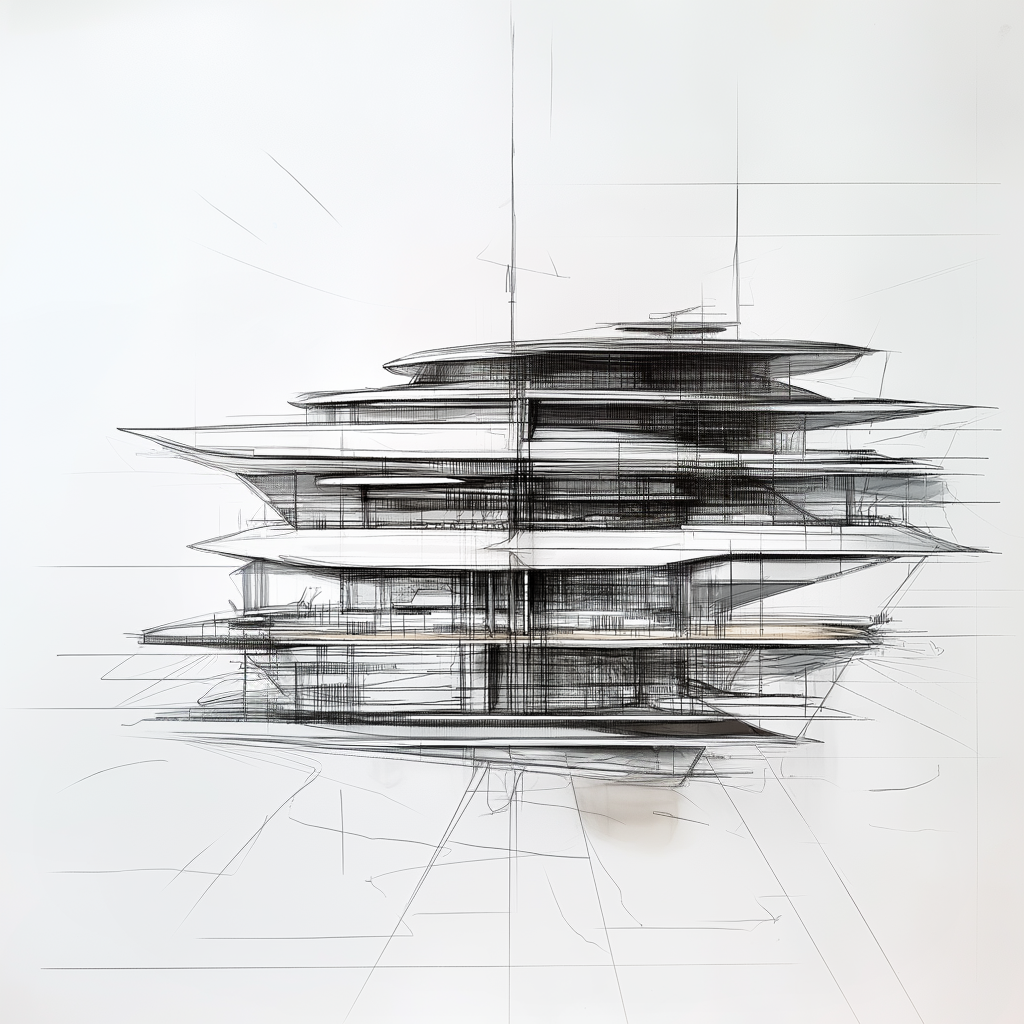
© OJrnl. All rights reserved
Compositional Dynamics: Layering for Life
Across the series, layering is the dominant gesture. These are not stacked towers in the conventional sense. Instead, they read like suspended slices—each one slightly offset, creating a dance of void and mass, transparency and opacity.
This strategy creates an internal life: terraces become gardens, interstitial spaces become social nooks, circulation routes become scenic journeys. Each level contributes to a rhythm of compression and expansion. This undulation is not just formal. It affects acoustics, wind passage, spatial mood. A narrow floorplate compresses activity; a flared roof calms it.
These are not floors; they are topographies. Part yacht, part cliffside villa, part orbital module these buildings are hybrids. Their forms defy typological clarity. But this hybridity is where innovation lives. When architecture borrows freely from other disciplines, new programs emerge. A floating library?
A research station disguised as a hotel? A community hub shaped like a private observatory? Each drawing teases these questions. Form here becomes a prompt, not a conclusion. It asks not “what is this for?” but “what could this become?”
Eniviroment as a Design Partner
Few forms are as inherently responsive to climate as the yacht. The translation of this into architecture suggests a future where buildings do not dominate their environments but adapt to them.
These designs hint at a deeply responsive architectural approach passively cooling interior spaces through cross-ventilation between stratified layers, while leveraging deep cantilevers to create natural self-shading. Rainwater is thoughtfully harvested across sloped deck surfaces, and roof planes are subtly angled to maximize solar integration, ensuring every element contributes to both environmental performance and spatial elegance.
This is form as response, not decoration. It is performance by necessity. In a time of environmental urgency, this formal intelligence becomes more than a design move. It becomes a moral imperative.
Docking and Drifting: Translating Yacht Movement from Suburb to City
Yachts don’t anchor where they are built. They drift, dock, depart adapting fluidly to geographies. Architecture can do the same. In suburban settings, yacht-form structures can extend horizontally, blurring boundaries with garden zones and natural topography. They become floating habitats, integrating with water bodies, open lawns, or cliffside perches.
In contrast, in urban centers, the same language compresses and rises. Curved planes tighten into vertical towers. Decks stack but still flare outward where space allows. Circulation becomes compact yet scenic like spiral staircases hidden in ship interiors.
This is mobility translated into morphology: in the suburbs, a yacht glides alongside nature; in the city, it docks with strategic precision, making every edge serve both the skyline and the street. The yacht’s choreography approach, anchor, departure mirrors architecture’s opportunity to adapt across diverse urban ecologies.
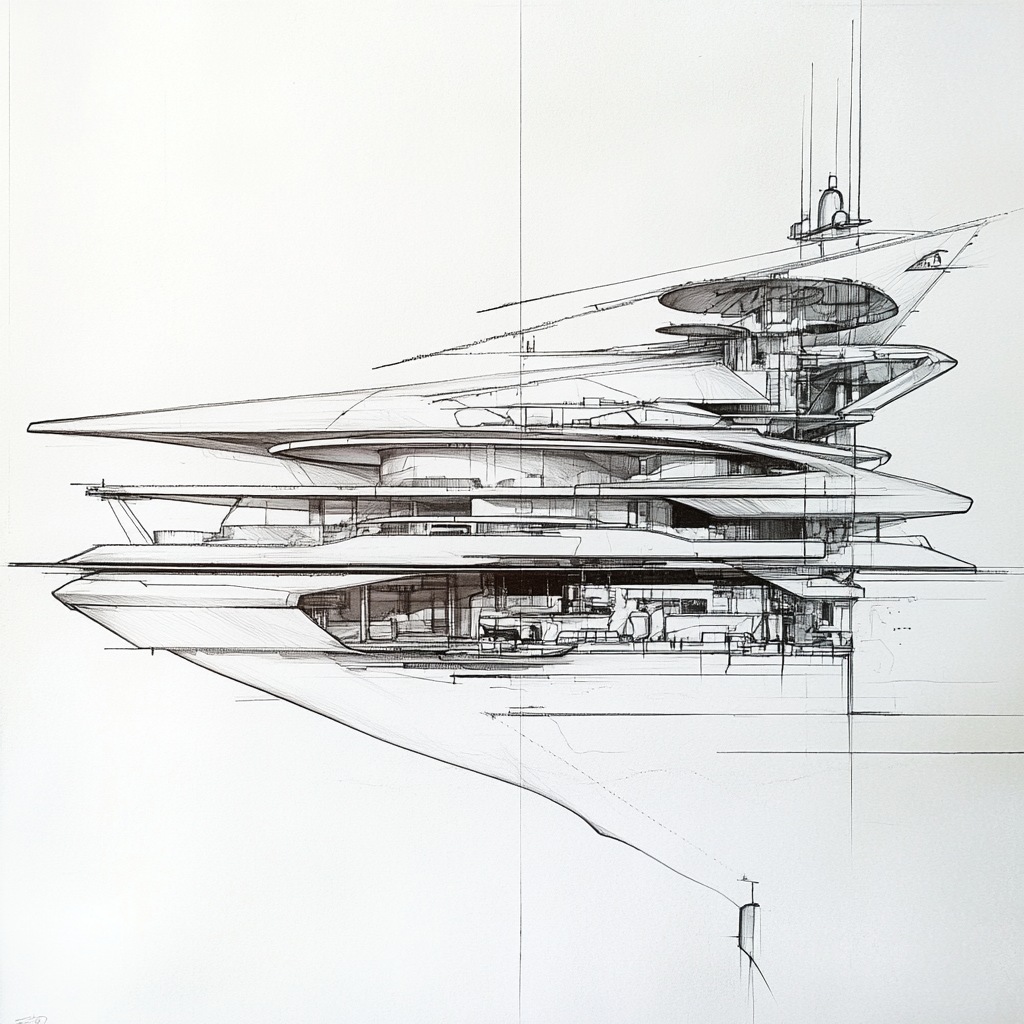
© OJrnl. All rights reserved
Form Variation and Spatial Programming
Each iteration of the form yields distinct interior conditions. Where decks flare outward, communal programming thrives lounges, cafés, and co-working environments open to views and breezes. Where the hull tightens, private rooms are housed, offering controlled light, narrow corridors, and moments of stillness. In asymmetrical models, unexpected adjacencies emerge: an amphitheater beside a greenhouse, a gallery floating above a pool.
This sensitivity to form-function alignment turns architecture into choreography. Movement is anticipated, not prescribed. Each step is curated by the shape of the building itself.
Psychological Impact: Form as Emotion
The user doesn’t just see these forms they feel them. There is a psychology to curvature. A comfort in enclosure. A thrill in cantilever. The architecture elicits emotional reactions long before it delivers physical ones. In spaces that tilt or project, there is exhilaration. In forms that wrap and cradle, there is grounding. This emotional modulation is subtle but powerful. It creates architecture that is not just functional or beautiful, but empathetic.
The speculative nature of these designs allows us to imagine more than just signature buildings. They gesture toward a new architecture of infrastructure fluid in form, modular in logic, and resilient by design. What if schools, clinics, or emergency shelters were based on this logic? Could we deploy architecture that grows like coral, that nests into climate zones, that moves when needed? These aren’t just dreamscapes. They’re prototypes and their strength lies in their ability to shift, respond, and evolve.
Porosity = Possibility: Same Density, Different Destinies
Density is not defined by numbers alone it is shaped by how space breathes. Two developments may occupy the same volume, yet their porosity determines entirely different experiences. Traditional blocky forms may reach the same FAR (floor area ratio), but they seal air, light, and community out. Yacht-inspired forms, by contrast, invite fluid thresholds perforated façades, breezeways, layered setbacks, and vertical voids.
The result is a city block that feels less like a container and more like a living mesh. A street of these buildings can offer privacy without opacity, depth without darkness, complexity without congestion. Porosity allows for moments between moments: glimpses of sky, corners of calm, frames of nature. And it is in those moments that urban life gains texture.
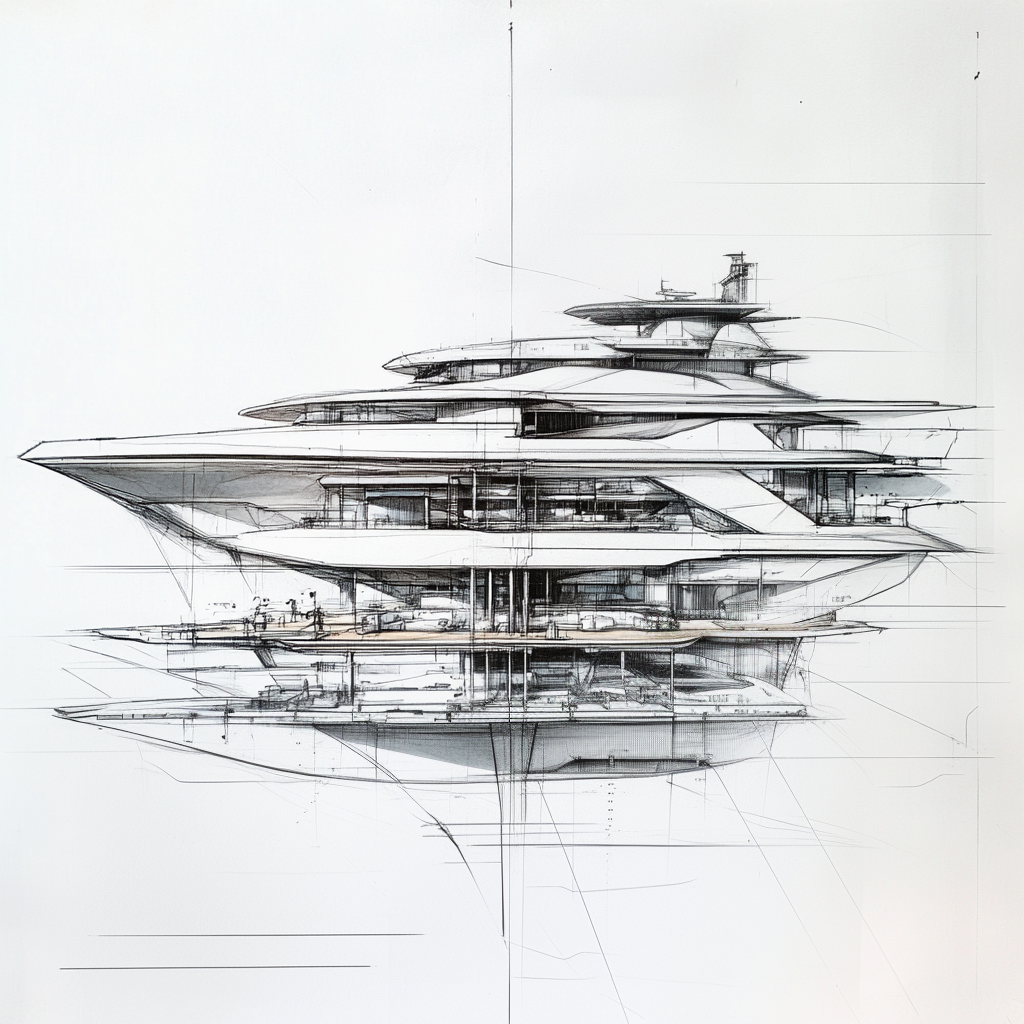
© OJrnl. All rights reserved
Urban Implications: Vertical Coastalism
In rapidly urbanizing regions, particularly along coastlines, the yacht-informed typology offers an alternative to the glass monolith. These forms propose a verticality that is porous and habitable, not sealed and aloof. They suggest cities that aren’t divided by function, but layered by experience. Retail, residence, recreation, and reflection become intertwined. Shade becomes infrastructure. Air becomes architecture. These hybrid forms invite us to think beyond zoning and embrace an ecological urbanism shaped by climate and culture alike.
These buildings challenge static occupation. They ask us to live within a geometry that curves, tilts, and adapts to the body and its breath. To be part of an environment that reflects our shifting rhythms rather than containing them. This is more than biomimicry or style. It is an ethics of space one that respects the intelligence of form and the dignity of human use. It offers us not just a future we can look at, but one we can inhabit, reshape, and sail through.
Embedding Elegance: How Yacht Forms Fit the Streetscape and Celebrate Coastal Living
The challenge of translating aerodynamic, expressive architecture into the constraints of a street-facing context is not one of reduction, but integration. Yacht-informed forms need not clash with existing urban language they can reinterpret the rhythm of the streetscape. Along coastal edges, these buildings echo the legacy of promenade culture, anchoring themselves with public plazas, cascading terraces, and layered sightlines.
The hull-like curves offer natural continuity with dune formations, harbor lines, and cliff contours, creating a visual language that respects the geography while adding sculptural sophistication. Instead of a sharp break from the city’s grain, these forms can become transitional seams, where nature, neighborhood, and futurism converge.
The Art of Elevating to Honor and Lowering to Humble: Rethinking Circulation
Circulation is choreographed with intent. As in yacht architecture, elevation reveals, bringing the body into alignment with horizon, atmosphere, and perspective. Descending brings one inward, into hulls and into shelter. This movement can be honored in buildings.
To elevate is to reveal to offer reverence to observation. It is a gesture of orientation, of aligning the body with horizon and sky. To lower is to ground to draw one inward. It humbles the body, slows the breath, and frames enclosure as a form of care.
Now imagine entering a building not on axis, but along a diagonal. A line that resists symmetry and invites exploration. This shift disorients gently, redirecting movement through nuance and curiosity.
Space unfolds, not as a sequence of rooms, but as a terrain of thresholds, each elevation and descent a spatial proposition.
These gestures choreograph emotional transitions. They guide us not just spatially but spiritually. In an age of over-exposure, such spatial dignity is a kind of design mercy an architecture of posture, presence, and pause.
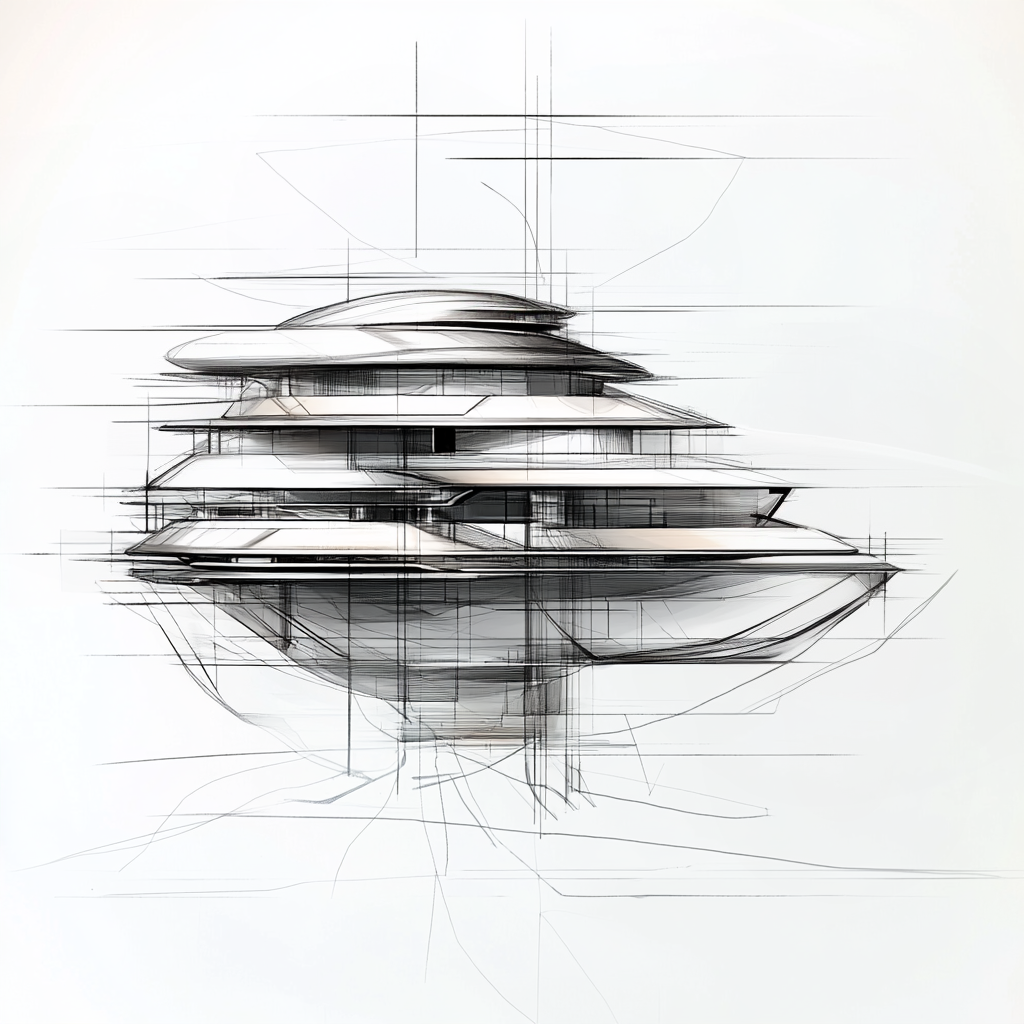
© OJrnl. All rights reserved
From Form to Service
In the end, the drawings offer more than aesthetic pleasure. They propose a way of thinking where form is a living system. Where beauty and utility are indistinguishable. Where architecture becomes not just shelter or symbol, but service. This is what happens when architecture listens to climate, to movement, to human need.
The result is not static. It is kinetic, relational, and deeply humane. These buildings don’t just sit. They sail and in doing so, they carry us into new territories of design, of responsibility, of hope. To view architecture through the lens of service is to elevate its societal role. It becomes a catalyst for care, a platform for exchange, and a shelter for vulnerability.
These yacht-informed structures, by nature and necessity, ask us to dwell with intention, to engage the environment without conquering it, and to respond to challenges with grace rather than force.
This is not about form following function in the traditional sense, but about function being folded into form integrated, invisible, yet deeply felt. When circulation becomes choreography, when shading becomes sculpture, and when porosity becomes a policy, we move beyond static typologies.
We begin to build with empathy. As we edge into an era shaped by climate adaptation, mass migration, and ecological recalibration, these designs present not escape, but engagement. They are not fantasy vessels but civic tools, crafted to float between past traditions and future urgencies. Let these forms be read not only as architecture sketches, but as attitudes. As invitations to consider what it means to live not above nature or each other, but with.
As we navigate a shifting world, may we choose to move like these structures do: light, adaptive, and deeply attuned to the spaces we grow and live in.